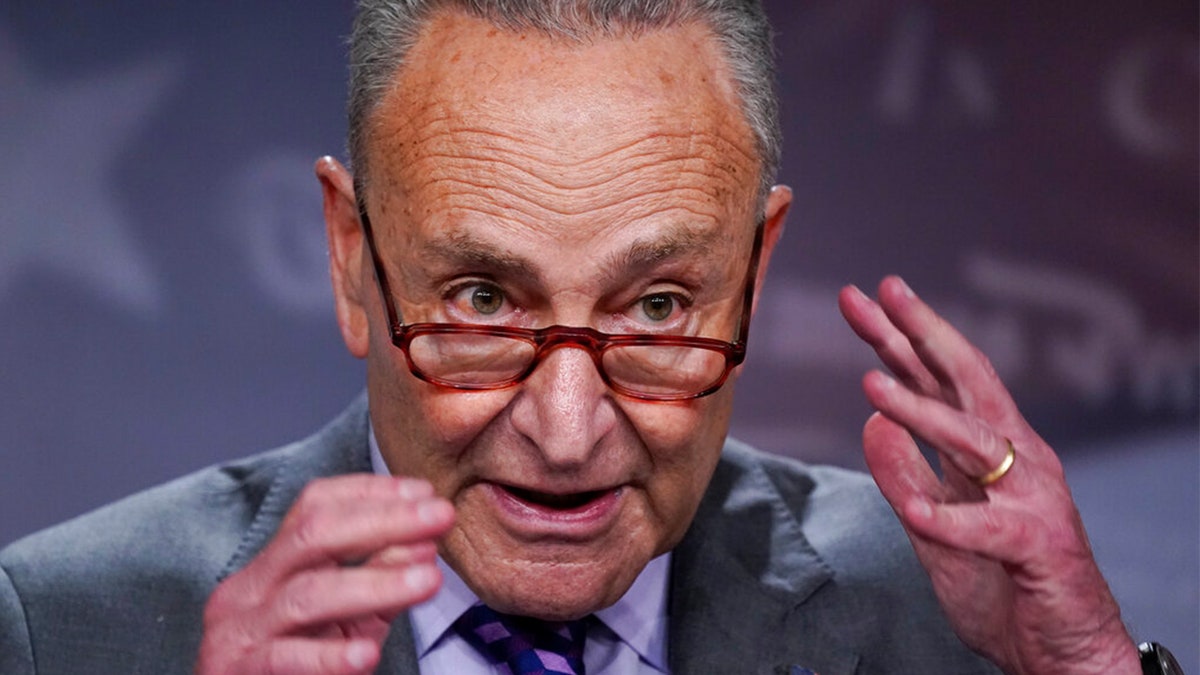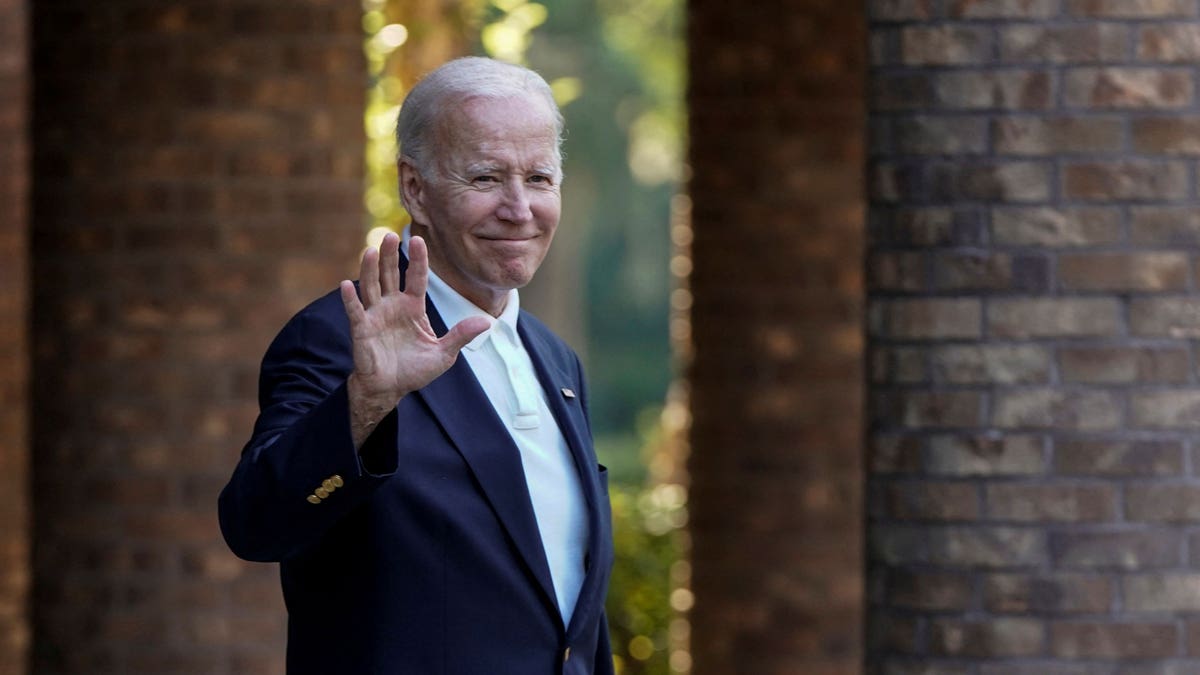Democrats want to squeeze every dollar out of Americans’ pockets for their ‘wasteful’ spending: Rep. Byron Donalds
Florida Republican Congressman Byron Donalds discusses the ongoing "vote-a-rama" for Democrats’ latest spending bill that includes a mass hiring of IRS employees.
Democrats passed about $3.8 trillion in spending on their top agenda items since President Biden took office — something they believe will help them in the 2022 midterms, but that Republicans say is the usual tax-and-spend legislation that will harm the economy.
"Democrats, even in this tough situation — polarized 50-50 — can actually get things done," Senate Majority Leader Chuck Schumer, D-N.Y., said after Democrats passed their Inflation Reduction Act this month. "They're going to see Democrats are actually getting things done that matter to them, mainstream things that matter to folks."
"No matter what they call their legislation, Democrats in Washington are addicted to spending your money," Chad Gilmartin, a spokesman for House Minority Leader Kevin McCarthy, R-Calif., told Fox News Digital. "When Democrats said their multitrillion spending bill would ‘rescue’ the economy — it did the opposite by fueling historic inflation and imperiling every family’s budget.
"Now Democrats say their latest spending bill, which also raises taxes during a recession, will ‘reduce’ the impact of their failures," Gilmartin said. "It’s clear Americans want a new direction to get our nation back on track."

Senate Majority Leader Chuck Schumer, D-N.Y. (AP Photo/J. Scott Applewhite)
The single most expensive of Democrats' major pieces of legislation was also their first — the $1.9 trillion American Rescue Plan (ARP). That was followed in 2021 by the bipartisan infrastructure bill, which was supported by all Democrats and a smaller number of Republicans and which cost $1.2 trillion in new and baseline spending.
Democrats were then stymied for the better part of a year as they struggled to come to a deal on their Build Back Better reconciliation bill and made little progress on other priorities.
But over the summer, they managed to pass a $280 billion bill to compete with China and a gun control bill with $20 billion in spending. Both had some GOP support, particularly in the Senate. Finally, they passed the Inflation Reduction Act — the reconciliation revamp of Build Back Better — with estimates ranging between $430 billion and $480 billion in combined spending and tax credits.
President Biden signed that bill into law Tuesday.
"For a while, people doubted whether any of that was going to happen," Biden said. "We're in a season of substance. … Today is part of an extraordinary story that has been written by this administration and our brave allies in Congress."

House Speaker Nancy Pelosi, D-Calif., navigated a small majority and divisions in her caucus to pass multiple major bills during this Congress. (Saul Loeb/AFP via Getty Images)
In total, Democrats' biggest agenda items amounted to approximately $3.8 trillion or more in new spending in less than two years.
Democrats didn't achieve all of their economic agenda, which included trillions more in proposed spending. But what they did accomplish, they say, will help them in the midterms.
"While Democrats have been delivering landmark legislation in areas with immense bipartisan public support, House Republicans are descending deeper and deeper into an extreme MAGA echo chamber that is incomprehensible to mainstream America," Henry Connelly, a spokesperson for House Speaker Nancy Pelosi, D-Calif., told Fox News Digital. "Somehow, in the past few weeks, House GOP Leadership has managed to vote on the same side as the Chinese Communist Party, Big Pharma and wealthy tax cheats while opposing sick veterans’ health care and birth control."
Even some Republicans are acknowledging Democrats' success in passing their agenda as of late — even as they blame that agenda for the near-record inflation that's widely attributed, at least partially, to the American Rescue Plan and other Democrat spending.
"Schumer has had the longest 50-50 Senate in history. And he has managed to get virtually all of their signature priorities through," Sen. Josh Hawley, R-Mo., said in frustration as Democrats were on the verge of passing the Inflation Reduction Act. "And with, by the way, the most unpopular president of my lifetime … and often with Republican help. It's really quite extraordinary."

FILE - President Biden signed the Inflation Reduction Act into law on Tuesday. (Reuters/Joshua Roberts)
ANALYSIS SUGGESTS INFLATION REDUCTION ACT WILL REDUCE ANNUAL INFLATION BY ONLY 0.1 PERCENTAGE POINTS
The overall deficit impact of Democrats' spending will be somewhat offset by revenue raisers in the bills. Democrats' reconciliation bill, for example, is expected to raise more than $700 billion in tax revenue.
But R Street Institute policy director for governance Jonathan Bydlak told Fox News Digital that those are almost insignificant compared to Democrats' historic spending of taxpayer dollars.
"Obviously, the spending increases are dramatically more," he said. "That tendency is one that all presidents and all Congresses tend to follow. … There may be efforts around the margin to reduce the deficit. But it's not really serious when you're talking about multitrillion dollar increases in new spending."
Republicans also aren't innocent when it comes to spending when they're in power, Bydlak said.

Congress approved several trillion dollars of spending related to COVID-19 during former President Donald Trump's time in office. (AP)
"If you sort of sum up the estimates provided by the Congressional Budget Office, Trump signed into law about just shy of $580 billion during his first two years in office," Bydlak said. "To put that into context, that's roughly comparable to what we saw [on average for each two-year Congress] during the last six years of the Obama presidency."
CLICK HERE TO GET THE FOX NEWS APP
That number then exploded during the COVID-19 crisis when former President Donald Trump and the divided Congress approved several trillion dollars in emergency spending. "Literally the Trump presidency spent more in four years than Obama spent in eight," Bydlak said.
But even with the pandemic crisis phase waning, Democrats didn't dial back on the spending when they took over in 2021.
"There are two things that have been, until recently, the kind of big signature achievements of the Biden presidency," Bydlak said, referring to the Rescue Plan and the infrastructure bill. "Those two bills alone were literally putting Biden nearly on the path to spend more in his first year than Trump spent his entire time in office. … We're close to the point where Biden's spending in his two years in office is essentially even with Trump's last two years in office, which included all of his … various COVID packages."
Bydlak added: "There's a difference between spending at the height of a pandemic when we were basically seeing a massive decrease in demand vs. spending now where we're seeing kind of rampant inflation."






